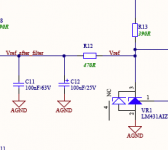I vaguely recall seeing and using something like this (either a zener diode or a BJT's reverse-biased BE junction) used as an audio noise source in a music synthesizer. It didn't take much amplification to get 1VRMS of noise.Well, I can tell you that standard zeners run in starvation mode (low current) are excellent noise sources.That particular problem bit me in the butt one time while working on a HV shunt regulator that used stacked transistors. I thought clamping the bottom transistor with a zener would be nifty, but it turned out a resistor was much (much, much) less noisy due to the low currents involved.
Reverse biased transistor B-E junctions make nice sharp low current 7.5-8V zeners, but I have no idea about how noisy...
Would a TL431 be lower noise than a zener. I have read that the ones from ONSEMI are the lowest noise of the various mfgs.
The 431 is not a zener. It's a bandgap reference.
What are you up to? If you want low noise you can add a low pass filter.Which are the lowest noise Zener Diodes, either SMD or through hole, which are in current production, regardless of price?
Attachments
I ran into that issue not too long ago, and wondered whether a combination of lower and higher voltage zeners would offset each other. It seems lower voltage units have a positive tempco while larger voltages have a negative tempco (or maybe its the other way 'round). I didn't go far with it, but it remained on my mind.I just wish they werent so sensitive to airflow over them, ie. tempco variation
What does it mean?I find a lot of improvement in the high frequencies of the amp.
Did your amp's frequency response/gain/damping/THD change in any way?
How would you know?
I have replaced the 40 volts (20VX2) zener in the lowTIM amp with a shunt regulator and I find a lot of improvement in the high frequencies of the amp.
Gajanan Phadte
Got a schematic or reference for that? I'd very much like to try that on my Leach amplifiers. I can measure distortion down to nearly .001% and test noise levels to follow up on your observations.
Last edited:
What does it mean?
Did your amp's frequency response/gain/damping/THD change in any way?
How would you know?
The difference could be even heard by a deaf man. It is so much.
@Damon Hill
The amp is LEACH low TIM and I have constructed shunt regulator of the front end of RMI-FC100 designed by Mihai. I used 39 volts zener instead of 36 volts.
http://www.diyaudio.com/forums/solid-state/192925-leach-low-tim-frontend-tweak-3.html
Gajanan Phadte
Last edited:
Initially, I was thinking that the shunt regulator is an overkill, but then I had a need for +/-30 volts for my preamp. Then I used this 40 volts on a potential divider and connected a series pass darlington.
That made a low noise psu for the preamp and all that shunt regulator construction was found well worth.
Gajanan Phadte
That made a low noise psu for the preamp and all that shunt regulator construction was found well worth.
Gajanan Phadte
Last edited:
Quote:
Originally Posted by JMFahey View Post
What does it mean?
Did your amp's frequency response/gain/damping/THD change in any way?
How would you know?
Nice anecdote, but you *still* don't explain what the difference is or anything to back it up.The difference could be even heard by a deaf man. It is so much.
Gajanan Phadte
By the way, I trust *any* measurement much more than a deaf man's word.
It is strictly on the highs. The low level highs can be heard and are very clean.
I am capable of measurements but do not have any test instruments even at work, thanks to computers and asics.
Sorry, can't help with that.
@Damon Hill
The Leach amp is very good at mids and highs. This shunt regulator has improved it still further on the highs. However it needs a buffer and a good high dynamic preamp at the input. Mine has Nico's premp and Pedja Rogic buffer but I would have preferred the one with the complementary jFETs. The premp and the buffer are direct coupled to each other followed by an MKP 4.7mfd to Leach. If you are looking for good lows, you should increase the Iq of the LEACH to 150mA.
Gajanan Phadte
I am capable of measurements but do not have any test instruments even at work, thanks to computers and asics.
Sorry, can't help with that.
@Damon Hill
The Leach amp is very good at mids and highs. This shunt regulator has improved it still further on the highs. However it needs a buffer and a good high dynamic preamp at the input. Mine has Nico's premp and Pedja Rogic buffer but I would have preferred the one with the complementary jFETs. The premp and the buffer are direct coupled to each other followed by an MKP 4.7mfd to Leach. If you are looking for good lows, you should increase the Iq of the LEACH to 150mA.
Gajanan Phadte
Last edited:
- Status
- This old topic is closed. If you want to reopen this topic, contact a moderator using the "Report Post" button.
- Home
- Design & Build
- Parts
- Lowest noise Zener Diodes?
